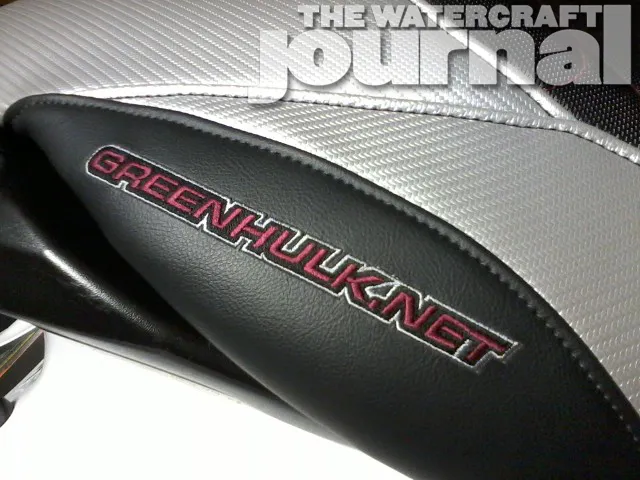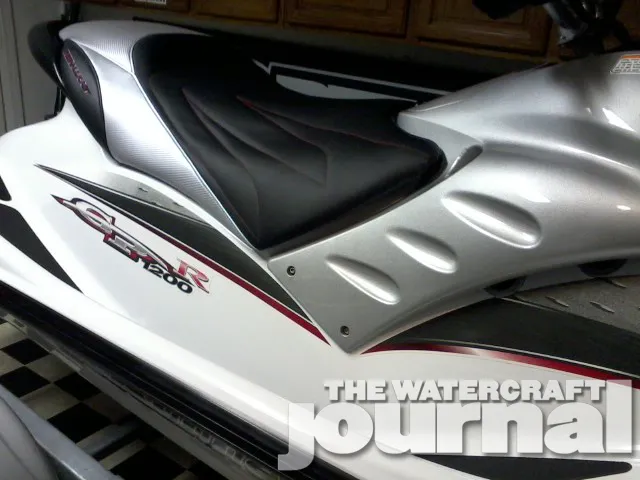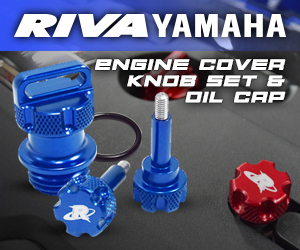As it stands, the world’s fastest personal watercraft holds the record at 112 miles per hour. That number has yet to be officially repeated since Maikel Gonzales’ epic run this past July. Emboldening all of those in contention for the Speed Alley championship, Gonzales record run effectively painted a large red target on the drag racer’s back. Replicating that kind of speed requires the perfect blend of power-to-weigh-to-hull design and many feel they have what it takes to challenge Gonzales’ “Blue Zone” conversion ski.
One such machine stands out among the others, as it breaks away from the conventional Yamaha GP1300R hull-and-Rotax 4-tec 3-cylinder combination. Slidell, Louisiana’s Keith Salles‘ original plan was far removed from his final result, but the journey to a SHO-powered GPR capable of 107-plus-miles per hour is a tale all unto itself.

“I purchased the ski from a warehouse where it was stored and covered up on a pallet for approximately 7 or 8 years,” Salles began. “We had initially set the ski up with a stock motor and aftermarket supercharger impeller, our custom intercooler, a V-Tech ECU flash as well as miscellaneous other things and the ski ran 96mph on the GPS. After this, we wanted to step it up considerable so we built a custom turbo setup and had the motor fully built.”
Prior to deciding on the big displacement 1.8-liter Yamaha SHO motor, Salles sought about perfecting the hull for such high speeds. “I brought the hull to Ben Herman of Ben’s Performance Plus in Jackson, Mississippi. He’s known for building some of the world’s fastest two-stroke GPR skis. He basically set the hull up for me which included setting the shoe to his custom specs, installing a stainless steel GP800 intake grate with upgraded billet mounting bosses, installed a pump tunnel reinforcement, which is needed at the higher speeds the ski is capable of. He basically prepped the hull and made it safe at speeds at or over 100mph.”

The engine was sent off to Brad Mattei of Mattei’s Cycle Supply in New Orleans East, Louisiana. Salles said, “Brad is also a long time friend of mine who has been with me for years in the sport bike drag racing scene. He has been my crew chief for years and has been a motorcycle mechanic and engine builder his whole life, specializing in late model four-stroke 4-cylinder motors.”
Pressing air through the SHO would require a lot of work. For that, Salles reached out to long time friend, Jesse Gonzalez. “[Jesse] shares performance interests with me. [He] completely fabricated the turbo kit and intercooler setup. [He fabricated] the merge collector (the V-looking funnel) for the header as well as the dump pipe off the turbo for the exhaust (the Y-looking piece). All the piping is fully water jacketed stainless steel and all one-off pieces.

On the hull, the GPSHO has a FF GPR Jim’s Performance modified ride plate. “The pump is a stock Yamaha SHO pump with a custom made prop, and modified venturi nozzle to achieve the desired ride plate angle we’re after,” Salles detailed. “[We] custom-made pressure relief valves mounted to the venturi nozzle as well as the bored aluminum steering nozzle.”
When it came time to prove the GPSHO, there was no time for testing. Arriving at the race site’s launch ramp on Saturday, at 3am the morning of the Hydrodrag World Finals, in Tavares, Florida, Salles and crew knew they had a full day ahead of them.

“We pulled into the race site around 3am and sat in the truck until we heard Kristian on the lake testing with his Silver Bullet turbo FZR. I said ‘We’re going to race, not to sleep.’ After finalizing a few things with Mike Young Sunday morning, …we decided not to test and race off the trailer, being we tuned the morning before in Slidell and I made adjustments relative to what the weather was scheduled to be in Tavares. This allowed us to hang out more and work less, which is essentially what we wanted to do.
“We didn’t run as fast as we tuned or planned to, but I’ve heard from several people that ‘this lake isn’t that fast’ and ‘don’t expect to make big mph on a GPR.’ The way I saw it was everyone is racing the same water, so we’ll give it a shot. It’s unfortunate we never had time to tune the hull between runs, because I’m pretty sure I could have gotten a handle on it and got that bounce out.”

Nevertheless, at its debut run, the GPSHO ran a lightning-fast 107.4mph earning Salles and crew the coveted first place in the Unlimited Speed Alley competition. He beamed, “We’ll be back and look forward to hanging with all you guys again. Thanks to everyone who supports the events and has a hand in making them happen.” Between now and then, Salles plans on making a few more modifications to ion out the aforementioned “bounce” and eke out a few more miles per hour prior to the beginning of next year’s HydroDrag series. Until then, we’ve got a lot of videos and images of the build below to enjoy.



































